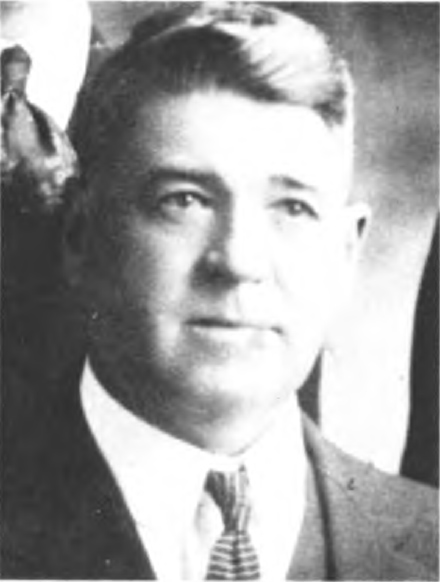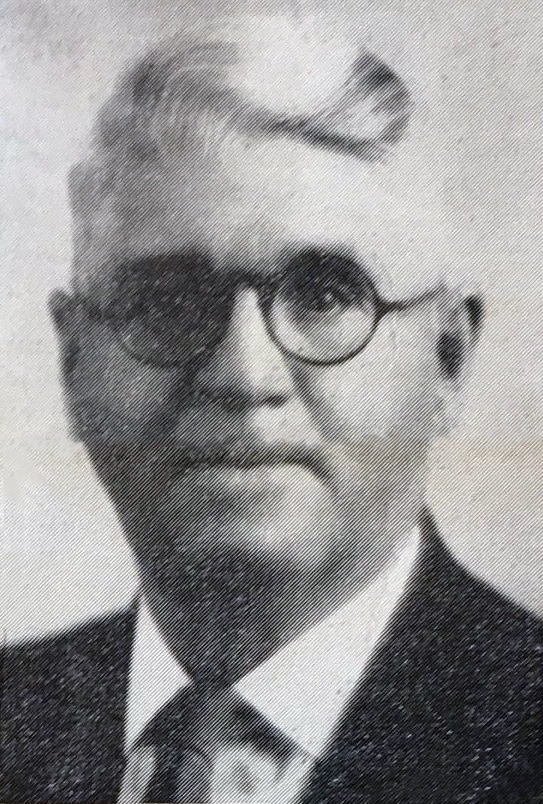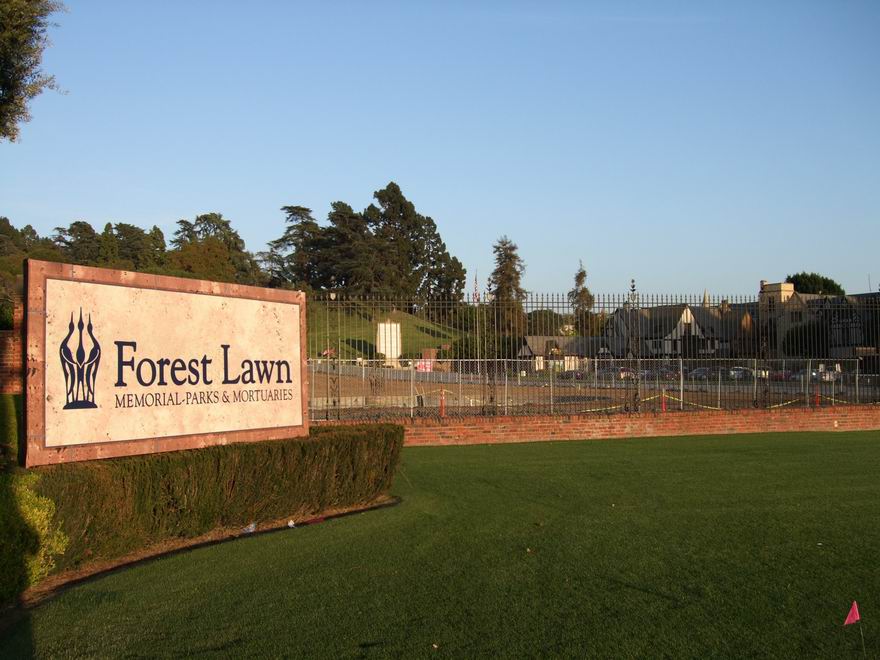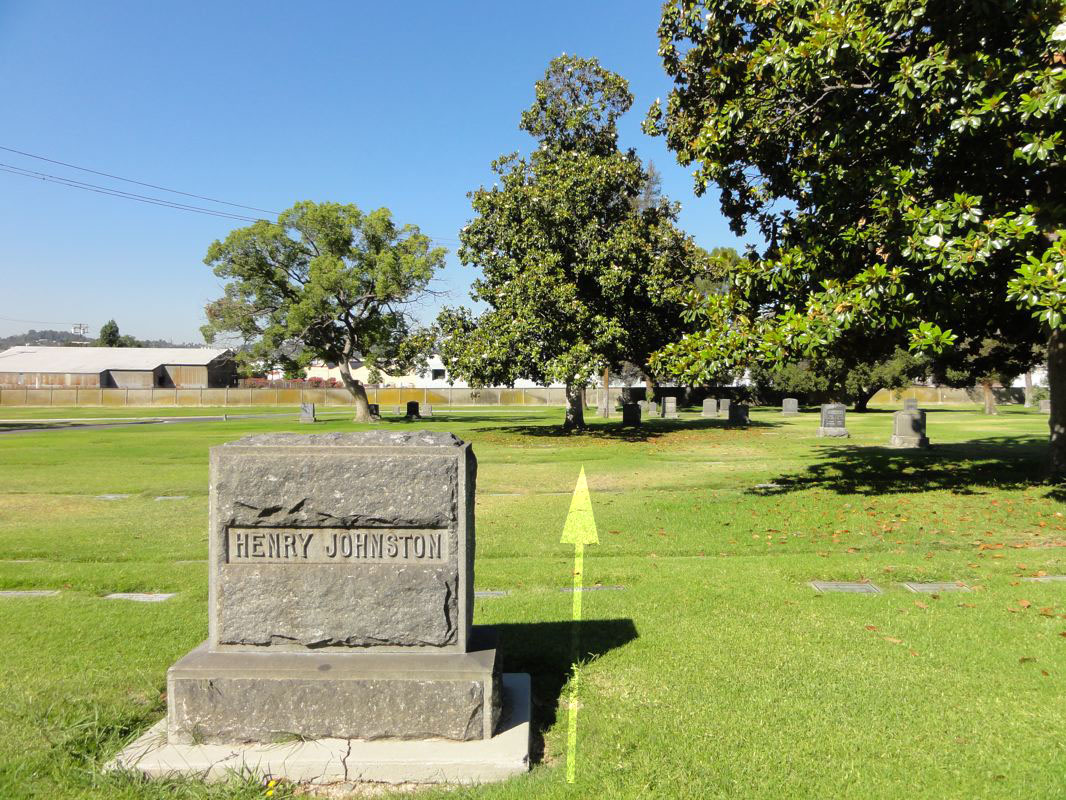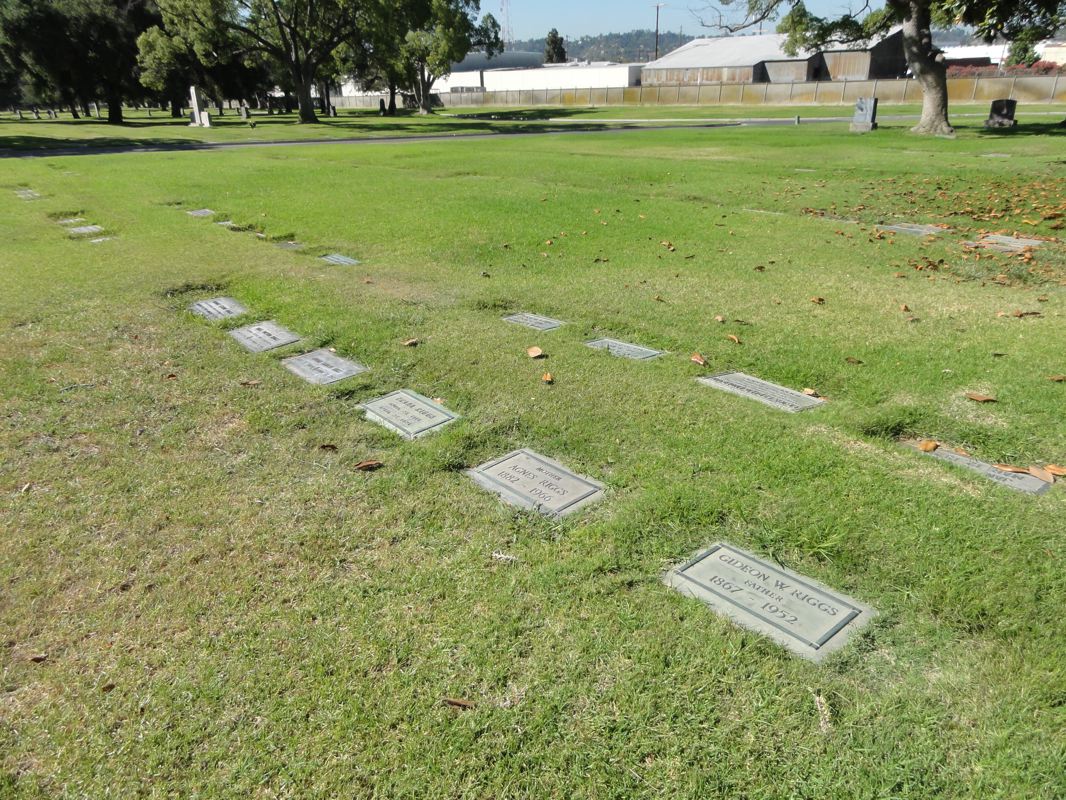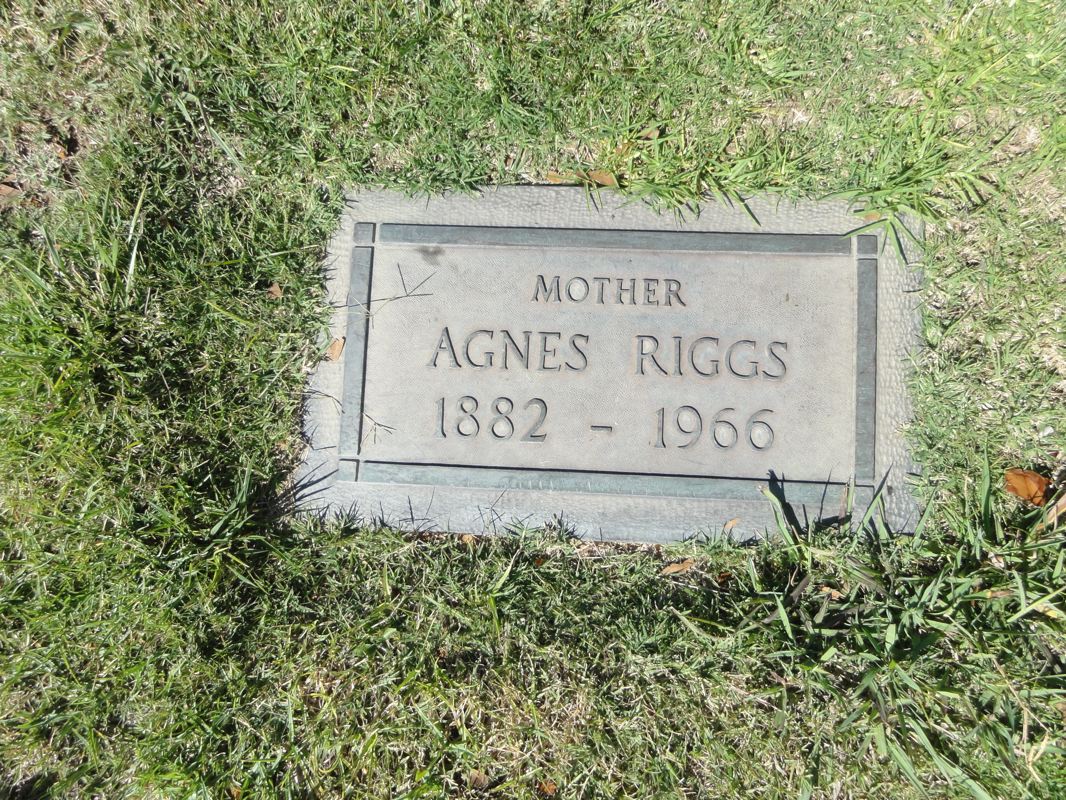Gideon Wright Riggs, Jr.
1867-1952
![]()
G.W. Riggs, Jr.
 Gideon Wright Riggs, pioneer gospel preacher in one of the most difficult mission fields in the nation, California, was born March 18, 1867 about thirty miles South of Nashville, Tennessee in Williamson County. He was the oldest child of Gideon Wright and Nancy Allen Jordan Riggs. The Riggs family had been in that area for many years. His grandfather went there from North Carolina to take possession of a farm of eight hundred or a thousand acres of land in 1810. He had fought in the battle of New Orleans under General Andrew Jackson. A Turnpike ran North and South through his farm and a county road ran East and West through it. His grandfather built a nice two story brick house at the intersection of these roads, and it was in this house that the subject of this sketch was born and grew up. His grandfather kept a post office named, “Riggs Crossroads,” near the town of College Grove. His grandfather died in 1871 and the big farm was divided among three heirs. His father inherited the brick house, with two hundred and fifty acres of land. After Gideon had become well established in California, he said of this place, “. . .no other place has felt exactly like home to me.” His father operated the farm with three tenant farmers, and they might be either white or black. He grew up with black children, and said, “When I was a boy I had no race prejudice whatever.” The Civil War had ended only two years before his birth, and the Riggs family suffered the poverty brought on by that terrible event along with the population in general. When Gideon was only twelve years old, his father died, leaving a widow with seven children, of whom Gideon was the oldest. His mothers parents and one of her brothers came to live with them and they continued to operate the farm, still using tenant labor. Farm products were very cheap, but somehow she managed to care for her children, and provide them with the educational opportunities available. As each one grew up, she gave him/her a horse.
Gideon Wright Riggs, pioneer gospel preacher in one of the most difficult mission fields in the nation, California, was born March 18, 1867 about thirty miles South of Nashville, Tennessee in Williamson County. He was the oldest child of Gideon Wright and Nancy Allen Jordan Riggs. The Riggs family had been in that area for many years. His grandfather went there from North Carolina to take possession of a farm of eight hundred or a thousand acres of land in 1810. He had fought in the battle of New Orleans under General Andrew Jackson. A Turnpike ran North and South through his farm and a county road ran East and West through it. His grandfather built a nice two story brick house at the intersection of these roads, and it was in this house that the subject of this sketch was born and grew up. His grandfather kept a post office named, “Riggs Crossroads,” near the town of College Grove. His grandfather died in 1871 and the big farm was divided among three heirs. His father inherited the brick house, with two hundred and fifty acres of land. After Gideon had become well established in California, he said of this place, “. . .no other place has felt exactly like home to me.” His father operated the farm with three tenant farmers, and they might be either white or black. He grew up with black children, and said, “When I was a boy I had no race prejudice whatever.” The Civil War had ended only two years before his birth, and the Riggs family suffered the poverty brought on by that terrible event along with the population in general. When Gideon was only twelve years old, his father died, leaving a widow with seven children, of whom Gideon was the oldest. His mothers parents and one of her brothers came to live with them and they continued to operate the farm, still using tenant labor. Farm products were very cheap, but somehow she managed to care for her children, and provide them with the educational opportunities available. As each one grew up, she gave him/her a horse.
Religious influence seems to have been rather scant, but when he was four years old a preacher named Davis came into the community, wanting to preach. There was no meeting house, so his grandfather gave him permission to preach in a beautiful beech grove fronting the turnpike. There was no Church of Christ in the community, but several people obeyed the gospel and a congregation was started. They built a good two story building on the ground where the meeting had been held. The upper story was used as a church house, and the lower floor was used as a school house. Brother Riggs said, “It was fortunate for me that the church was started or I might not have learned about the Church of Christ at all.
Though no explanation was given for it, he attended a Methodist Sunday School until he was about fifteen years old. He was deeply impressed with the religious instruction he had there, and when he was thirteen years old he went to the mourner’s bench every night for about a week, but he was unable to get the miraculous baptism of the Holy Spirit the Methodists claimed one would get. He joined the Methodist church anyway. Some of the tenants on his mother’s farm convinced him that the mourner’s bench system was wrong. The two most convincing passages they used were John 9:31 (We know that God heareth not sinners: but if any man be a worshipper of God, and doeth his will, him he heareth.) and Acts 2:38. (And Peter said unto them, Repent ye, and be baptized every one of you in the name of Jesus Christ for the remission of your sins; and ye shall receive the gift of the Holy Spirit.) He said he then knew what one must do to be saved, but it was eight years before he had the courage to do it. On August 16, 1890 he was baptized in the Harpeth river. The following Sunday he was asked to lead a prayer in worship, and he did. From that time he was often used in a public way in the worship. At the time of his baptism he was still in school, and the teacher one day asked the students to write on a piece of paper what they wanted to be. He wrote: “I had rather be a preacher of the gospel than to possess the wealth of the Rothchild family.” He continued, “Why did I want to preach?” “Not to make money, for preachers, as a rule, made but little money. Not for worldly fame, for preachers were not very famous in the eyes of the world, but because he believed human beings have an immortal soul that will spend eternity in heaven or hell, and he believed the gospel was the only power to save them.”
When he was a young man he moved to Texas. I do not have the details on that move, but he must have stayed there for some time. When he was about thirty years old he returned to Nashville and entered the Nashville Bible College. (Now Lipscomb University) He continued in school here for about five years, beginning in 1897. He had begun to preach and while in school preached somewhere nearly every Sunday and held many Evangelistic meetings in vacation time.
In 1900 Brother Michael Sanders, a Christian business man then living in Phoenix, Arizona, made a trip to the East to visit his family. He returned by way of Nashville where he spent a week or ten days, with much of the time being spent on the Nashville Bible School campus. He was a veteran of the Union Army in the Civil War and had been injured at Vicksburg. But he was now a successful business man and a faithful Christian who was interested in planting The Cause in the great West. He talked with Brother Riggs about it, and when he left they corresponded during the two years it took for Brother Riggs to complete his work there. In June of 1902 Brother Riggs and Brother J.H. Haines went to Phoenix, where Brother Sanders was living. He obtained a tent and the other things needed for meetings, and they went to work preaching the gospel. They worked through that summer in Arizona, and in November they took the tent to Los Angeles. This became “home” for the rest of his life. Of his association with Brother Sanders, he wrote: “I had no agreement with Brother Sanders about money matters as to how much I would receive for my efforts, but he treated me as a son, and when he died he remembered me in his will which has enabled me to live thus far without depending upon the church.” (What a wonderful thing for a man of wealth to do with his money, or at least, some of it!)
In the summer of 1903 he returned to Nashville to marry Miss Agnes Jones on August 11 in Antioch, Tennessee. She was a faithful Christian, the daughter of David and Susan Nance Bush Jones. She shared his interest in preaching the gospel and faithfully walked by his side to the end of his long life. Six sons and a daughter were born to them. They are: Gideon Sanders Riggs, David Gillespie Riggs, Mary Lee Riggs Lantz, John Newton Riggs, Luke Fulton Riggs, Frank Oliver Riggs, who died when he was only eight years old, and Robert Larimore Riggs "Bobby," the well known tennis player. After her children grew up, Sister Riggs became a member of the Wednesday Morning Women’s Club, of Los Angeles and developed an interest in the study of Shakespeare. The Shakespeare Society awarded her a certificate denoting the research and completion of a knowledgeable thesis. Their children gave them loving attention in their declining years, and strong family loyalty continues until this time.
Brother Riggs preached in Southern California, and within a relatively few years had established eighteen churches in the area. In 1904 a division came in the church, and those who remained faithful met in a tabernacle on Manitou Street. In 1910, with Brother Sanders still helping, they built the Sichel Street meeting house that has served faithful brethren for so many years. Brother Riggs held meetings in many places in the West, but his main area of work was in California, where he established The Cause in Colton, Riverside, San Diego, Dinuba, Bakersfield, Fillmore, Santa Paula, Fullerton, Alhambra, Yucaipa, and many others. In 1942 an article appeared in the West Coast Christian in which it was stated that about fifty churches had grown out of his work in Southern California. He was loved and respected by his brethren all through that area to the end of his long life. His birthplace in Tennessee was dear to him. and all through life he returned from time to time to the place of his birth to visit friends and relatives and to again preach the gospel to them in the little church at Riggs Crossroads. In the early years in California there was a strong bond of brotherly love among the California brethren. The Cause was so weak, the state was so large, and many of them had known one another “back East.” Brother Riggs was close to his preaching brethren, including such men as L.D. Perkins at Armona and W. Haliday Trice in San Francisco. Brother Perkins had lived in Southern California, but later moved to Armona in the San Joaquin Valley where he operated a store and preached all over the area. Many of these early day preachers had been students together in the Nashville Bible School.
Brother Riggs suffered a broken hip in 1949, and from this he never recovered. He also lost his vision several years before the end. On March 8, 1952 The Lord took him home. In ten days he would have been eighty five years old. The funeral service was conducted in the Church of the Recessional in beautiful Forest lawn Memorial Park in Glendale, California. Brother Hugh Tiner, then President of Pepperdine College, was in charge of the service. He was assisted by James H. Sewell, an elder of the Broadway and Walnut Street church in Santa Ana, and J. Emmett Wainwright, minister of the Central church in Long Beach, but once minister for the Sichel Street church. Sister Riggs continued until July 30, 1966, when she joined him in the better world. They sleep side by side in the Forest Lawn Park in Glendale. It is hard to evaluate such a life as Brother Riggs. As a young man he went to a very difficult mission field and gave his life to it. He saw The Church grow and prosper through the many years he worked there. It would be difficult to imagine a more productive life — one better lived. Surely he is among the redeemed “over there.”
-Loyd Smith, Gospel Preachers of Yesteryear, page 293-296
![]()
Gideon Wright Riggs
Gideon Wright Riggs was born March 18, 1867, at Riggs Crossroads near the small community of College Grove, Tennessee. 30 miles south of Nashville. He was born and reared on a farm. He obeyed the gospel at an early age.
In 1902, he was graduated from the Nashville Bible School in Nashville, Tennessee. On August 11, 1902, he was united in marriage to Miss Agnes Jones and to this union six boys and one girl were born. Soon after his marriage in 1902, he and sister Riggs moved to California where they began pioneering the gospel of Christ which resulted in the planting of the churches of Christ all over the central and southern arts of the state.
In his evangelizing, he was ably assisted by means furnished by Michael Sanders, a Christian businessman and a Civil War veteran who had been wounded in the Federal Army at the battle of Vicksburg, Mississippi.
In 1900, he visited the Nashville Bible School where he first met Riggs. Sanders talked with Riggs and persuaded him to leave everything and move to California.
Riggs held his first meeting in California under a tent in Long Beach in 1902. In January, 1903, he baptized ten people in a meeting with a little church in Pomona. In 1903, the tent was pitched in Los Angeles and out of the meeting grew the Sichel Street church in which Kiggs served as an elder for a number of years. Riggs helped to establish 15 or more congregations in the state.
G. W. Riggs held meetings all over the West and helped to establish many congregations especially in California in such places as Colton, Riverside, San Diego, Dinuba, Bakersfield, Fillmore, Santa Paula, Fullerton, Alhambra, Yucaipa, and other places.
He was the father of Bobby Riggs, who for many years was universally known as the leading tennis player.
Riggs was an active member and for many years served as an elder of the Sichel and Altura Street church, out of which grew about 15 congregations in the southern California area. At all the important meetings of the church in this territory, a chair was usually reserved for Riggs at the speaker's table. He sustained a broken hip in 1949 and had been confined to his bed after that. He had been blind for several years.
Gideon Wright Riggs, pioneer gospel preacher in California, passed from this life on March 8, 1952. In 10 days he would have been 85 years of age.
At the time of his passing he was survived by his wife, Agnes, and six children: Gideon Sanders of Los Angeles, David G. of Devonshire, Bermuda, Mrs. Mary Lee Lantz of Riverside, California, Sgt. John N. of the U.S. Army, stationed at San Francisco, California, Luke F. of San Gabriel, California, and Bobby, former national tennis champion who presently lives in Florida. A son, Frank, died in childhood. Funeral service was held at the Church of the Recessional in beautiful Forest Lawn Memorial Park, Glendale, California.
In keeping with the request of Riggs, Hugh M. Tiner, president of Pepperdine College, who had worked closely with Riggs for 20 years, had charge of the service. James H. Sewell, an elder of the Broadway and Walnut Street church in Santa Ana read the Scripture lesson and led the prayer. J. Emmett Wainwright, minister of the Central Church of Christ in Long Beach and who preached at the Sichel Street church for several years, spoke briefly of Riggs and his contribution to the cause of Christ in the Southern California area.
Few men living today will be able to see such progress of the cause of Christ in their lifetime as Riggs saw. May God give us more men such as he.
-Gussie Lambert, In Memoriam, pages 239-240
![]()
Getting Acquainted—
G.W. Riggs Pioneered Work In Los Angeles And The West
Bro. G. W. Riggs, the veteran preacher of the church in California, was born in Williamson County, Tennessee, March 18, 1867. He was in the old Nashville Bible College (now David Lipscomb) in Nashville, when Michael Sanders of Los Angeles, Calif., became so impressed with him while visiting in the south he invited him to come west.
Brother Sanders, with two other families, went to Long Beach to worship because there was no loyal church in Los Angeles. It was in 1902 that Brother Riggs and John Haynes arrived in Phoenix, Ariz., with a tent, financed by Brother Sanders, to hold a meeting. In December Brother Riggs, with the tent, arrived in Long Beach, California. From there ehe went to Pomona in January, 1903, the tent was pitched on a lot near the present Sichel Street Church and souls began to be added to the Lord.
It was August 11, 1903, that Brother Riggs went to Tennessee for a wife. They returned to Los Angeles in September and have been busy in the work of the Lord ever since. The church split in 1904. Those who remained loyal met in a tabernacle on Manitou Street and in 1910 Brother Sanders and others built the church house where Sichel Street Church with Billie Mattox as the present preacher is busier than ever to this day.
G.W. Riggs held meetings all over the west and helped to establish many congregations, especially in California in such places as Colton, Riverside, San Diego, Dinuba, Bakersfield, Fillmore, Santa Paula, Fullerton, Alhambra, Yucaipa, and others. He is the father of Bobby Riggs, the leading tennis player in the world.
Brother Riggs is active in the work and still a member of the Sichel and Altura Street Church, out of which has grown the 50 congregations in this Southern California area. He is loved and respected b y all who know him. At all important meetings of the church in this territory a chair is usually reserved for Brother Riggs at the speaker’s table.
Few men living today are able to see such progress of the cause of Christ in their life time as can this great man. May God give us more such as he and allow him to remain with us to behold yet greater things. On a postal card, just the words “thank you” would mean so much to him.
-Bio of Gideon Wright Riggs (1867-1952) in the West Coast Christian of January, 1942. Trivia note - G. W. Riggs son was one Bobby Larimore Riggs - Tennis Champion (he won Wimbledon in 1939) who defeated Margaret Court Smith and lost to Billy Jean King. I don't make this stuff up, I just report the facts! Note: contributed by Terry Gardner to Friend of the Restoration Facebook Group 03.07.2020
![]()
Invitation To Worship With Hollywood Blvd. Church of Christ
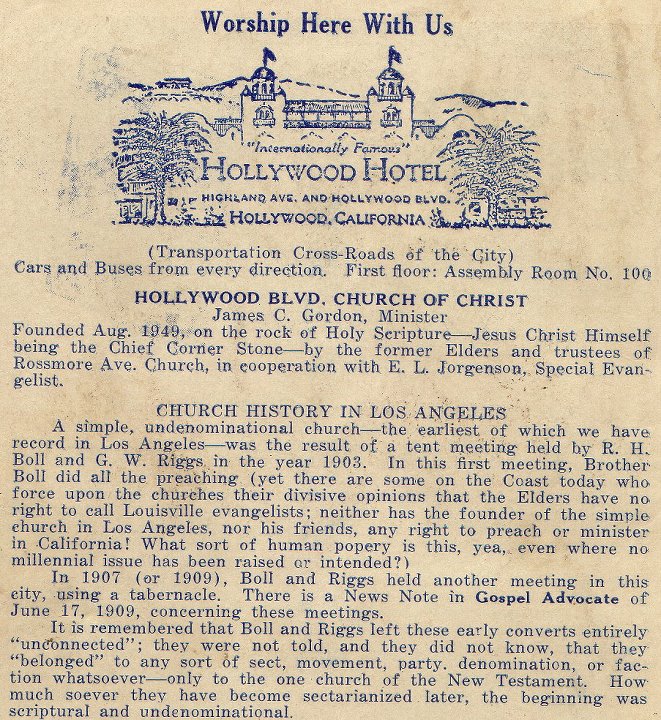
As Seen On Facebook March 18, 2013 by Hans Rollman
![]()
Directions To The Grave of G.W. Riggs, Jr.
G.W. Riggs is buried in Los
Angeles, California. Heading north out of L.A. on the I-5, take Exit
139B, The Gardendale Fwy, Hwy #2. Heading NE get off at the N. San
Fernando Rd. Exit and turn left. Go under the bridge and continue a
little less than a mile. Turn right on Glendale Ave. The Forest Lawn
Cemetery will be on the right, 1712 S. Glendale Ave. Enter through the
main gate (Cathedral Dr.) You will see the mortuary and offices on your
right. Just past the building is a road to the right
that goes behind the mortuary. Go down this road to the end of the buildings
and cross the first intersection you come to. The road straight ahead is called Westminster Rd. You will see a huge mausoleum straight ahead. Just before the mausoleum stop the car and enter the Section to your right. The Riggs family plot is in this section.
Special Note: Forest Lawn Cemetery is the final resting place of
many of Hollywood's stars and starlets. The park is massive, but most of these are in mausoleums.
Though I was not able to visit them all, the park and settings are some
of the most beautiful in all America. A list I found said that the
following are buried here: Clark Gable, Carole Lombard, Jimmy Stewart, Jean Harlow, Humphrey Bogart, Mary Pickford, Errol Flynn, Spencer Tracy, George Burns & Gracie Allen, W.C. Fields, Tom Mix, Sammy Davis Jr., Walt Disney, Red Skelton, Robert Young, Lon Chaney, Ethel Waters, Alan Ladd, Dick Powell, Robert Taylor, Wallace Beery, Ted Knight, Sam Cooke, Joe E. Brown, Sydney Greenstreet, Nat King Cole, Jack Oakie, Ed Wynn, Jack Carson, Norma Shearer, Chico Marx, Dorothy Dandridge, Robert Cummings, Sid Grauman, Dan Daily, William Boyd ("Hopalong Cassidy"), Marie Dressler ("Tugboat Annie"), Irving Thalberg, Casey Stengel, Larry Fine, Aimee Semple McPherson, Edward Everett Horton and Jean Hersholt, plus authors Louis L'Amour, Theodore Dreiser and L. Frank Baum. And, as of June 25, 2009, the legendary Michael Jackson. Note: I was in the cemetery on June 25, 2012, the third anniversary of his death. There were many people at the Great Mausoleum to pay their respects. Access to the mausoleum where Jackson and many other "stars" are buried is not allowed by the general public.
If you visit the park intending to see the graves of the stars, be
sure to find all the locations before you arrive. The people in the park
will not be helpful in locating the graves, as they are sworn to secrecy
for most of the famous ones interred there. However, a little research
on the web will help you find the locations of just about all listed
above.
GPS Location
34.122342,-118.24941
Plot Info: Section H, Lot 51-7
View Larger Map
![]()
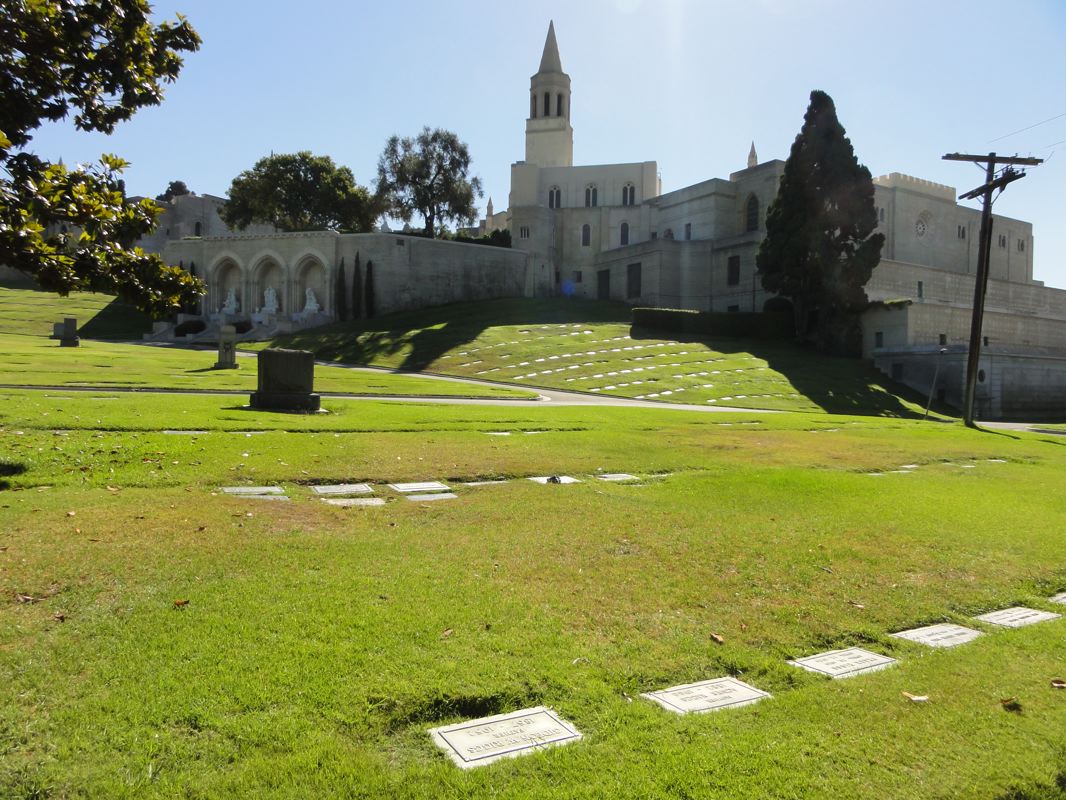
The Great Mausoleum In The Distance Houses Many Of The Stars of Hollywood.
This photo was taken on the third anniversary of the death of pop singer, Michael Jackson, who is buried in
the upper end of this mausoleum at Forest Hill Cemetery.

The Riggs Family Plot - 6 graves - G.W. Riggs on far right.

The Riggs Family Plot - 6 graves - G.W. Riggs on far right.
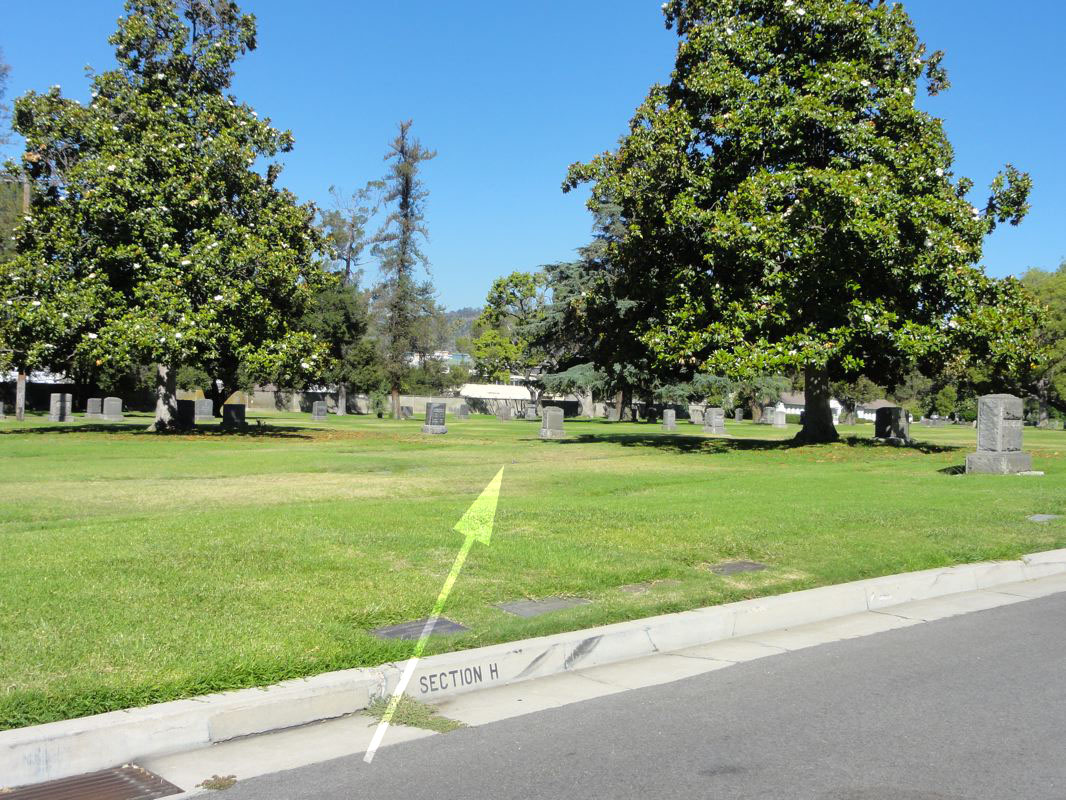
The Grave Location Of G.W. Riggs is Section H, Lot 51-7

Madge Exton Riggs
Wife, Mother and Grandmother
August 11, 1911 - August 9, 1992
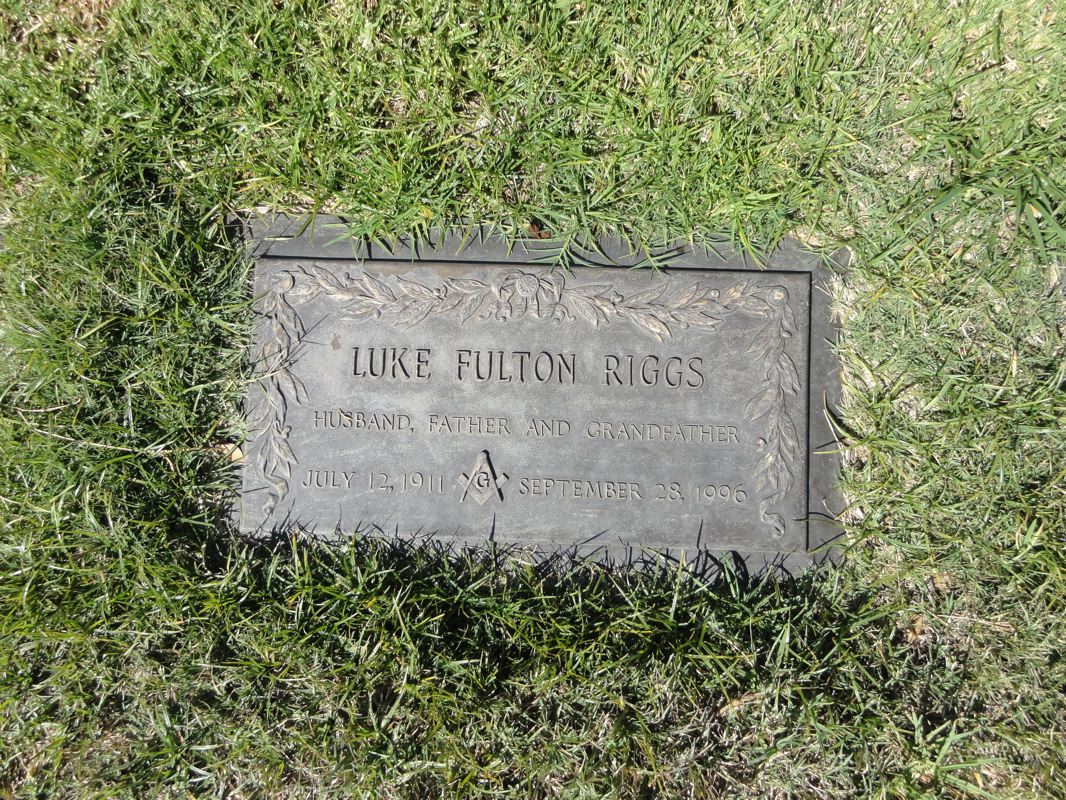
Luke Fulton Riggs
Husband, Father and Grandfather
July 12, 1911
September 28, 1996
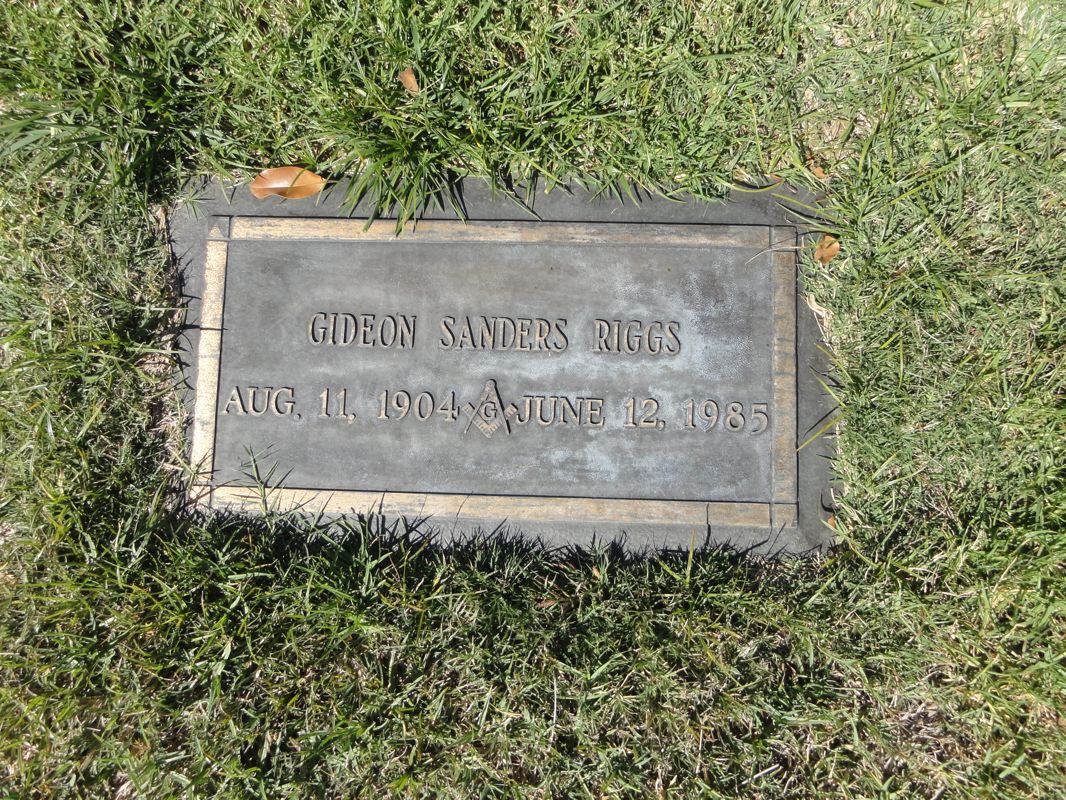
Gideon Sanders Riggs
August 11, 1904
June 12, 1985
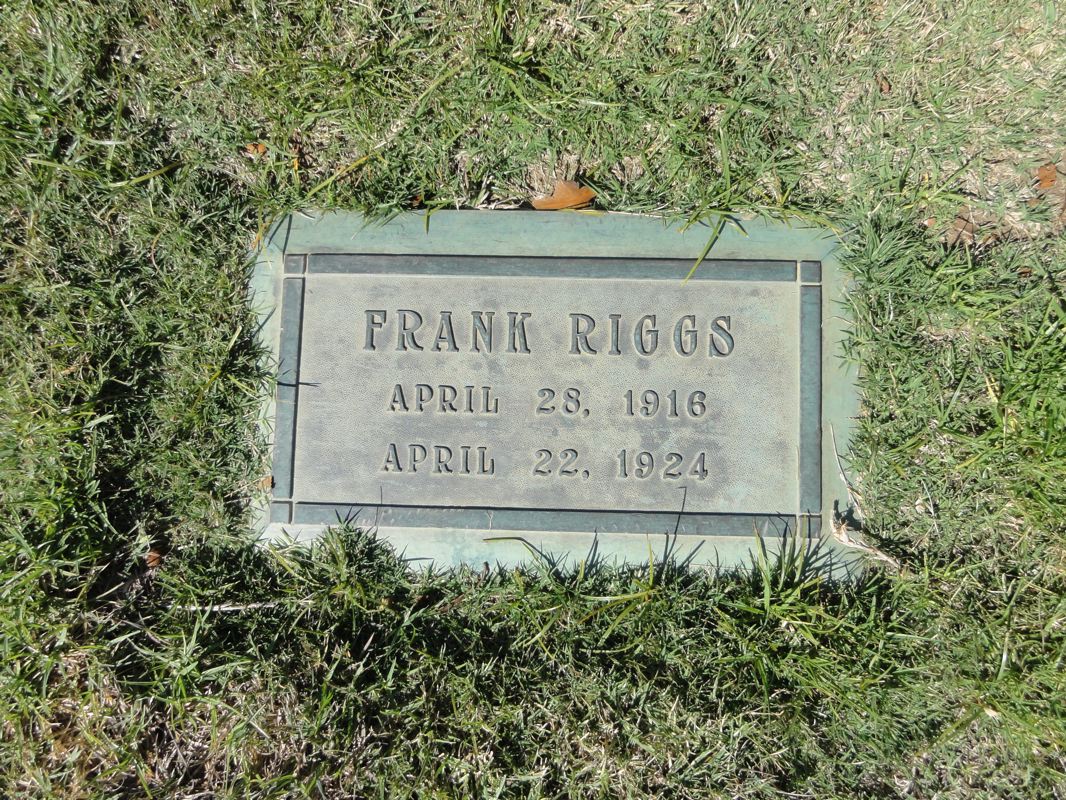
Frank Riggs
April 28, 1916
April 22, 1924
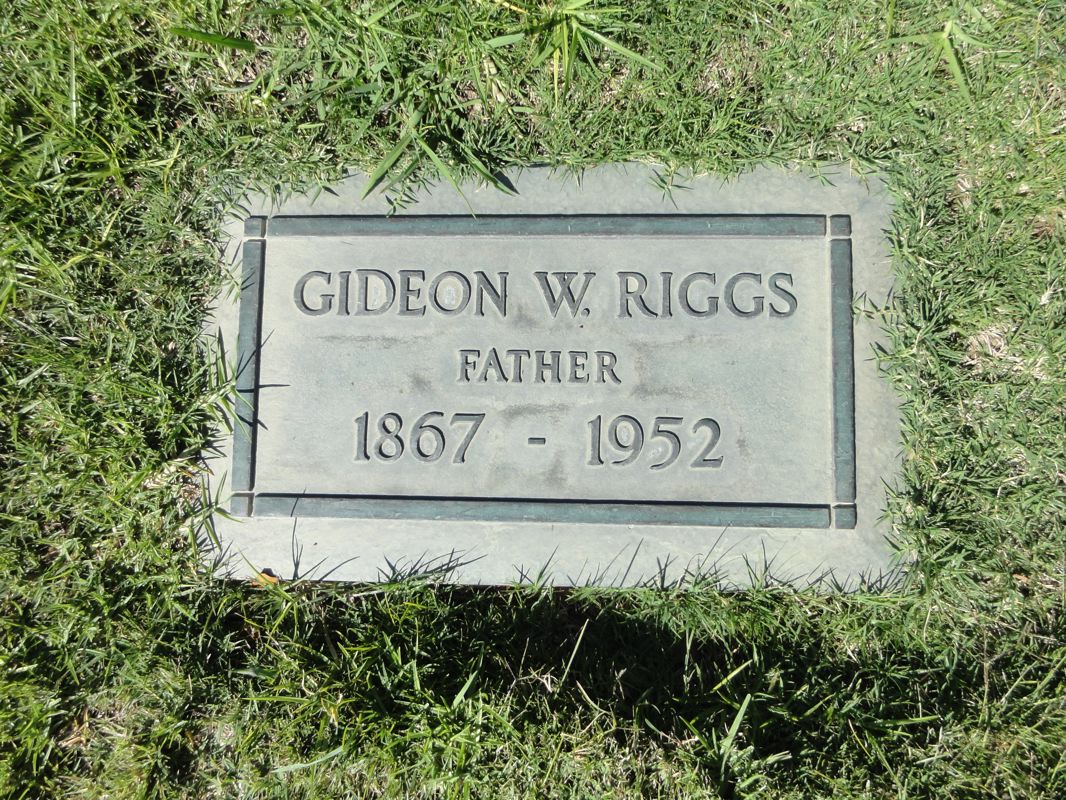
Gideon W. Riggs
Father
1867-1952
![]()
Photos Taken June 25, 2012
Page produced November 1, 2012
Courtesy of Scott Harp
www.TheRestorationMovement.com
Special Thanks: To Jerry Rushford. I was able to visit in the home of Jerry and Lori Rushford in late June, 2012. I was just returning from a mission trip to the Fiji Islands, and had about a 30 hour layover in Los Angeles. The Rushfords were wonderful hosts, and Jerry was a great resource in assisting me in the finding of the grave of G.W. Riggs. If visiting in the Los Angeles area, be sure to visit Pepperdine University in Malibu. Besides having a beautiful campus, be sure to visit the Church of Christ Historical Room, upstairs in the university library. Jerry Rushford has put much work through the years into preserving the history of the churches of Christ on the western coast of the United States of America.
Also Thanks to Hans Rollman for adding the photo of the young G.W. Riggs you see above on Facebook March 18, 2013. Added here May 10, 2013.
![]()
